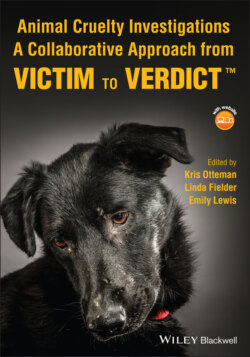Читать книгу Animal Cruelty Investigations - Группа авторов - Страница 127
3.3 Sanitation
ОглавлениеSanitation is a component of an animal's environment that often comes up as a significant factor in animal cruelty cases. Animals, like humans, prefer to live, sleep, raise their young, and eat in environments that are free from urine, feces, and other contaminants. When animals are confined in cages, pens, stalls, or even houses without attention to sanitation in the form of human intervention, their enclosures quickly become saturated with waste. This creates an unsanitary environment that is not only extremely unpleasant for the animal, but also subjects them to injury and illness. In practical terms, we do not mean that sanitary environments are sterilized and germ free, but we are expecting domestic animals to be kept in such a way that they can get free from their own waste. Constant exposure to feces and urine causes scalding wounds and accompanying infections, fumes from ammonia in urine‐soaked enclosures (Figure 3.2) lead to respiratory and eye irritation, and all manner of parasites proliferate in areas where feces build up over time.
Figure 3.2 The multiple wounds and abscesses on the dog in this photo can be attributed to the conditions within her run and shelter.
Source: Oregon Humane Society.
